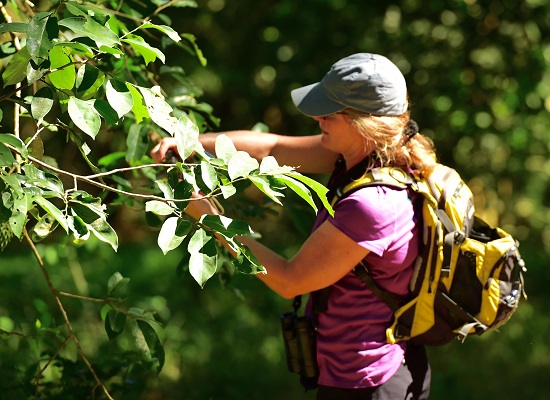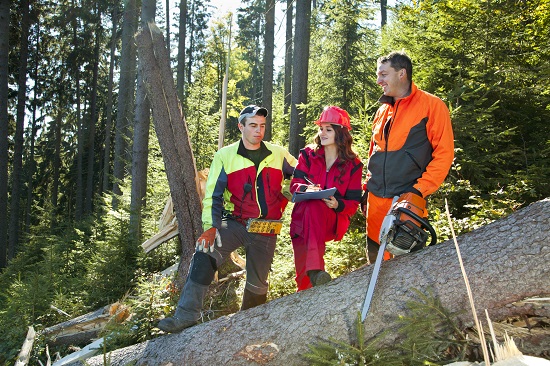Jobs for people who love being outdoors
Elka Torpey | July 2017
Some people can’t imagine working inside all day. For them, there’s good news: they may be able to join the thousands of workers who call the outdoors their office.
Outdoor careers often don’t fit a mold. Some workers spend their time in a single location, unloading cargo or constructing homes. Others may be on the move all day, delivering the mail or walking through nature preserves to catalog plants.
Although working in the open air may offer upsides, it’s not all sunshine and blue skies. Keep reading to learn why—and to learn more about some of the possibilities for careers outside.
Working in the open air
If you’re interested in working outside, you may have more options than you realize: according to the U.S. Bureau of Labor Statistics (BLS), nearly half of all jobs required outdoor work in 2016. For purposes of this article, an outdoor career is one in which at least some workers spend a large part of their workday doing tasks outside. Industry sectors with opportunities for employment outdoors include:
- Agriculture, forestry, fishing, and hunting
- Construction
- Leisure and hospitality
- Mining, quarrying, and oil and gas extraction
- Transportation and warehousing
- Utilities
Not all workers in these industry sectors are outdoors, of course, but at least some of them are. Even people who work primarily outdoors, however, may spend at least part of their time indoors.
As chart 1 shows, BLS projects growth in many of the industry sectors with opportunities for employment outdoors. The leisure and hospitality sector—which includes golf courses, nature parks, and recreational camps—is projected to add the most new jobs over the 2014–24 decade. Even in sectors that are projected to have employment declines—such as agriculture, forestry, fishing, and hunting—BLS still expects job openings to arise from the need to replace workers who retire or leave their occupation for other reasons.
Chart 1. Employment in selected industries with outdoor work, 2004, 2014, and projected 2024(1)
| Industry |
2004 |
2014 |
Projected 2024 |
|
Agriculture, forestry, fishing, and hunting
|
2,111,300 |
2,138,300 |
2,027,700 |
|
Construction
|
6,976,200 |
6,138,400 |
6,928,800 |
|
Leisure and hospitality
|
12,493,100 |
14,710,000 |
15,651,200 |
|
Mining, quarrying, and oil and gas extraction
|
523,200 |
843,800 |
924,000 |
|
Transportation and warehousing
|
4,248,600 |
4,640,300 |
4,776,900 |
|
Utilities
|
563,800 |
553,000 |
505,100 |
Occupations for outdoor employment
If you think you’d like to work outside, where would you most like to be: On the water? In the woods? Surrounded by wildlife—or kids?
Occupations with outdoor opportunities may be grouped by focus or work setting, such as
For selected occupations in each of those groups, the tables that follow show data on employment and self-employment in 2014, projected job openings from 2014 to 2024, and median annual wages in 2016. Compare the percentage of self-employed workers in these occupations with 6.2 percent, the proportion of all workers who were self-employed in 2014. And compare the wages with $37,040, the median annual wage for all workers in 2016.
On the water. There are thousands of jobs for people who want to work on the water. Some of these jobs offer opportunities for self-employment or are projected to have lots of openings. Many of the occupations shown in table 1 pay above the median, too.
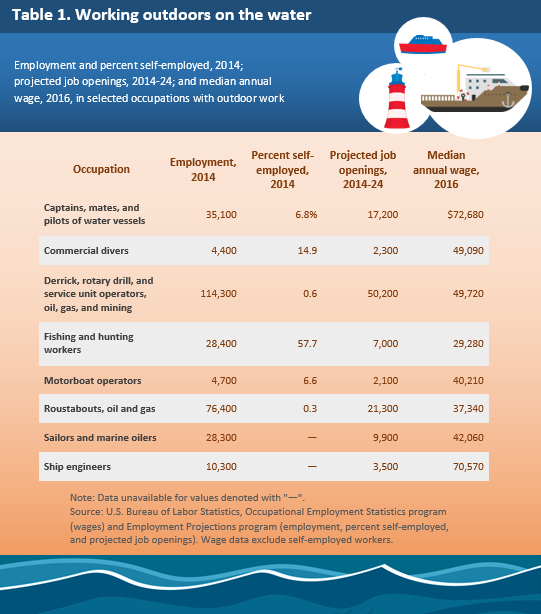
Table 1. Working outdoors on the water; employment and percent self-employed, 2014; projected job openings, 2014-24; and median annual wage, 2016, in selected occupations with outdoor work
| Occupation |
Employment, 2014 |
Percent self employed, 2014 |
Projected job openings, 2014-24 |
Median annual wage, 2016 |
|
Captains, mates, and pilots of water vessels
|
35,100 |
6.8% |
17,200 |
$72,680 |
|
Commercial divers
|
4,400 |
14.9 |
2,300 |
49,090 |
|
Derrick, rotary drill, and service unit operators, oil, gas, and mining
|
114,300 |
0.6 |
50,200 |
49,720 |
|
Fishing and hunting workers
|
28,400 |
57.7 |
7,000 |
29,280 |
|
Motorboat operators
|
4,700 |
6.6 |
2,100 |
40,210 |
|
Roustabouts, oil and gas
|
76,400 |
0.3 |
21,300 |
37,340 |
|
Sailors and marine oilers
|
28,300 |
— |
9,900 |
42,060 |
|
Ship engineers
|
10,300 |
— |
3,500 |
70,570 |
Workers may not need formal education to enter some of these occupations. Oil and gas roustabouts, for example, usually learn the skills they need on the job. In other occupations, such as commercial divers, workers typically need a certificate or other postsecondary nondegree award. Work experience in a related occupation also may be important. Ship officers, for example, might need to have first worked as a sailor before qualifying for the higher level position.
In the woods. If the forest is your preferred work locale, consider a career related to forestry and conservation or in logging. Table 2 shows some of these occupations, most of which have wages that are higher than the median for all workers.
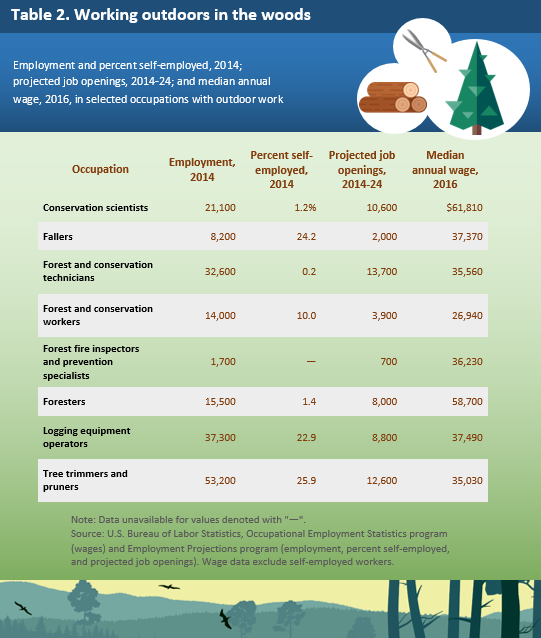
Table 2. Working outdoors in the woods; employment and percent self-employed, 2014; projected job openings, 2014-24; and median annual wage, 2016, in selected occupations with outdoor work
| Occupation |
Employment, 2014 |
Percent self employed, 2014 |
Projected job openings, 2014-24 |
Median annual wage, 2016 |
|
Conservation scientists
|
21,100 |
1.2% |
10,600 |
$61,810 |
|
Fallers
|
8,200 |
24.2 |
2,000 |
37,370 |
|
Forest and conservation technicians
|
32,600 |
0.2 |
13,700 |
35,560 |
|
Forest and conservation workers
|
14,000 |
10.0 |
3,900 |
26,940 |
|
Forest fire inspectors and prevention specialists
|
1,700 |
— |
700 |
36,230 |
|
Foresters
|
15,500 |
1.4 |
8,000 |
58,700 |
|
Logging equipment operators
|
37,300 |
22.9 |
8,800 |
37,490 |
|
Tree trimmers and pruners
|
53,200 |
25.9 |
12,600 |
35,030 |
To enter many of these occupations, you typically need a high school diploma. Forest and conservation technicians usually need an associate’s degree. And conservation scientists and foresters generally qualify for entry-level jobs with a bachelor’s degree. Forest fire inspectors and prevention specialists may need work experience as a firefighter or police officer to qualify for the occupation.
With people. Occupations that might involve working outdoors with children or adults are projected to have many job openings, and several of these occupations have higher-than-average rates of self-employment. Compared with the median for all workers, however, the occupations in table 3 have low wages.
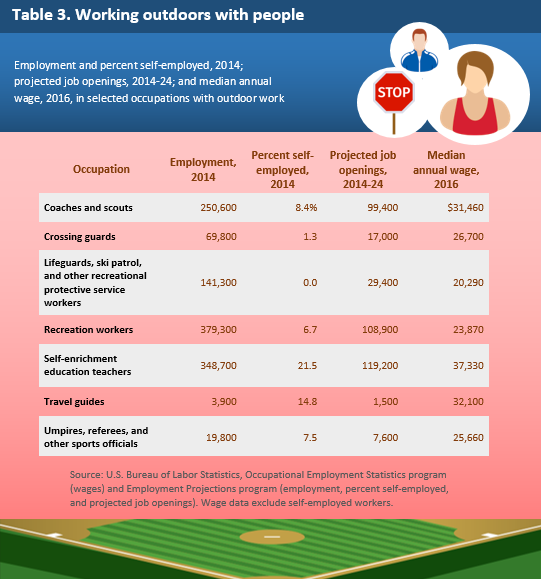
Table 3. Working outdoors with people; employment and percent self-employed, 2014; projected job openings, 2014-24; and median annual wage, 2016, in selected occupations with outdoor work
| Occupation |
Employment, 2014 |
Percent self employed, 2014 |
Projected job openings, 2014-24 |
Median annual wage, 2016 |
|
Coaches and scouts
|
250,600 |
8.4% |
99,400 |
$31,460 |
|
Crossing guards
|
69,800 |
1.3 |
17,000 |
26,700 |
|
Lifeguards, ski patrol, and other recreational protective service workers
|
141,300 |
0.0 |
29,400 |
20,290 |
|
Recreation workers
|
379,300 |
6.7 |
108,900 |
23,870 |
|
Self-enrichment education teachers
|
348,700 |
21.5 |
119,200 |
37,330 |
|
Travel guides
|
3,900 |
14.8 |
1,500 |
32,100 |
|
Umpires, referees, and other sports officials
|
19,800 |
7.5 |
7,600 |
25,660 |
You typically enter many of these occupations with a high school diploma or less education. Other occupations, such as coaches, may require a college degree at the entry level. Workers also frequently need on-the-job training to become fully competent. And self-enrichment education teachers typically need work experience in an occupation related to the subject matter that they teach.
With plants and animals. Some outdoor jobs, such as those on farms and ranches, involve working with plants and animals. Table 4 shows that the projected number of job openings over the 2014–24 decade vary for these occupations, as do their wages and rates of self-employment.
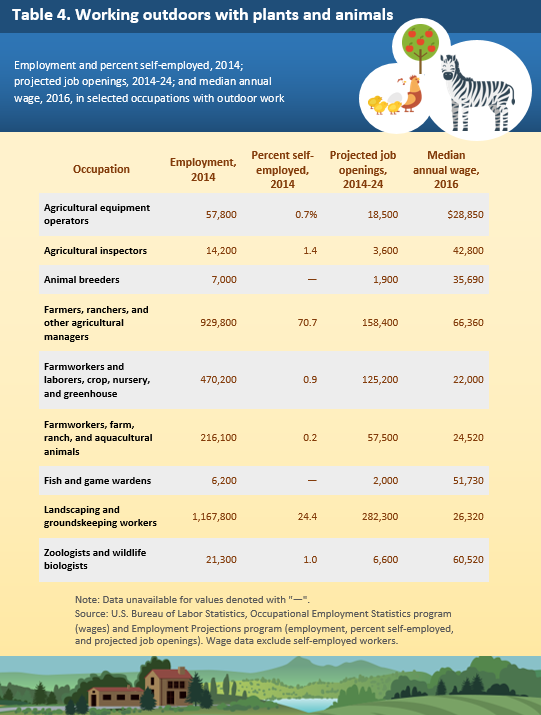
Table 4. Working outdoors with plants and animals; employment and percent self-employed, 2014; projected job openings, 2014-24; and median annual wage, 2016, in selected occupations with outdoor work
| Occupation |
Employment, 2014 |
Percent self employed, 2014 |
Projected job openings, 2014-24 |
Median annual wage, 2016 |
|
Agricultural equipment operators
|
57,800 |
0.7% |
18,500 |
$28,850 |
|
Agricultural inspectors
|
14,200 |
1.4 |
3,600 |
42,800 |
|
Animal breeders
|
7,000 |
— |
1,900 |
35,690 |
|
Farmers, ranchers, and other agricultural managers
|
929,800 |
70.7 |
158,400 |
66,360 |
|
Farmworkers and laborers, crop, nursery, and greenhouse
|
470,200 |
0.9 |
125,200 |
22,000 |
|
Farmworkers, farm, ranch, and aquacultural animals
|
216,100 |
0.2 |
57,500 |
24,520 |
|
Fish and game wardens
|
6,200 |
— |
2,000 |
51,730 |
|
Landscaping and groundskeeping workers
|
1,167,800 |
24.4 |
282,300 |
26,320 |
|
Zoologists and wildlife biologists
|
21,300 |
1.0 |
6,600 |
60,520 |
The education and training usually required to enter or become competent in these occupations vary, too. To qualify as a farmworker or laborer, for example, you typically need no formal education. But to get an entry-level job as a zoologist or agricultural inspector, you usually need a college degree.
Regardless of the level of education required, nearly all of the occupations in table 4 typically involve on-the-job training for workers to become competent. Farmers, ranchers, and other agricultural managers also typically need work experience in a related occupation, such as farmworkers or agricultural equipment operators.
In cities and towns. There are lots of options for working outdoors in residential and commercial areas. Some of the occupations are shown in table 5. In most of these occupations, wages were higher than the median for all workers, and a number of them are projected to have numerous job openings over the 2014–24 decade.
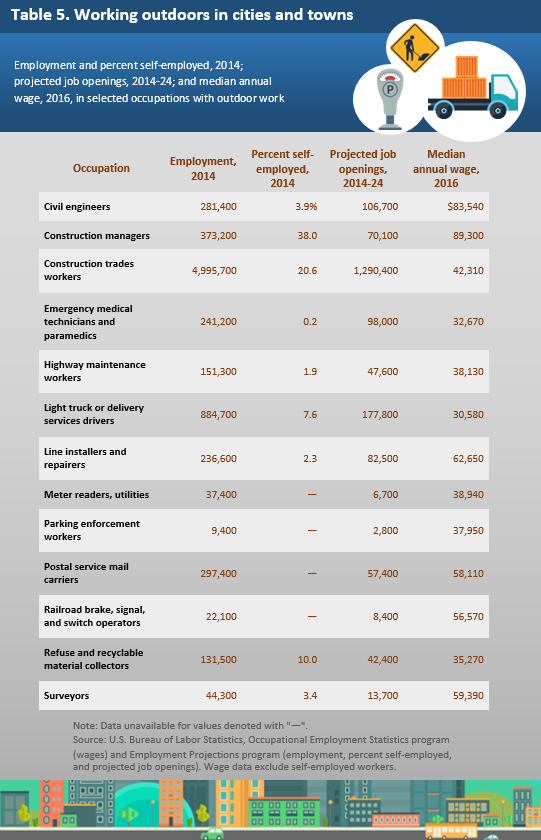
Table 5. Working outdoors in cities and towns; employment and percent self-employed, 2014; projected job openings, 2014-24; and median annual wage, 2016, in selected occupations with outdoor work
| Occupation |
Employment, 2014 |
Percent self employed, 2014 |
Projected job openings, 2014-24 |
Median annual wage, 2016 |
|
Civil engineers
|
281,400 |
3.9% |
106,700 |
$83,540 |
|
Construction managers
|
373,200 |
38.0 |
70,100 |
89,300 |
|
Construction trades workers
|
4,995,700 |
20.6 |
1,290,400 |
42,310 |
|
Emergency medical technicians and paramedics
|
241,200 |
0.2 |
98,000 |
32,670 |
|
Highway maintenance workers
|
151,300 |
1.9 |
47,600 |
38,130 |
|
Light truck or delivery services drivers
|
884,700 |
7.6 |
177,800 |
30,580 |
|
Line installers and repairers
|
236,600 |
2.3 |
82,500 |
62,650 |
|
Meter readers, utilities
|
37,400 |
— |
6,700 |
38,940 |
|
Parking enforcement workers
|
9,400 |
— |
2,800 |
37,950 |
|
Postal service mail carriers
|
297,400 |
— |
57,400 |
58,110 |
|
Railroad brake, signal, and switch operators
|
22,100 |
— |
8,400 |
56,570 |
|
Refuse and recyclable material collectors
|
131,500 |
10.0 |
42,400 |
35,270 |
|
Surveyors
|
44,300 |
3.4 |
13,700 |
59,390 |
Although many of the occupations in table 5 usually require a high school diploma for entry, a few have no formal education requirements. Roofers and construction laborers, for example—two construction trades worker occupations—typically qualify for entry-level jobs with less than a high school diploma. A bachelor’s degree typically is needed to become a construction manager, civil engineer, or surveyor.
For some of the occupations in table 5, on-the-job training of 1 month or more helps workers attain competency in their jobs. Apprenticeships are common for certain types of construction trades workers, such as carpenters and brickmasons. And surveyors need prior work experience as a survey technician.
Pros and cons of outdoor careers
As with nearly any career, working outside has its upsides and downsides. You need to decide whether the nonstandard schedules, harsh weather, and dangerous conditions prevalent in some of these jobs outweigh the fresh air, love of nature, and sense of pride they may also offer.
Work schedules for outdoor jobs often differ from the standard 9-to-5, Monday-to-Friday hours of many office jobs. For example, boat captains might be away from home for weeks at a time, working night, weekend, and holiday shifts. Selected outdoor occupation groups in which workers were more likely than average to be on the job early in the morning are shown in chart 2.
Chart 2. Selected occupation groups with early-morning hours
| Occupation group |
4:00 AM |
5:00 AM |
6:00 AM |
7:00 AM |
|
Total, all occupations
|
4.4% |
6.4% |
13.6% |
28.4% |
|
Farming, fishing, and forestry
|
8.1% |
12.5% |
34.6% |
56.3% |
|
Construction and extraction
|
2.1% |
6.0% |
19.1% |
51.8% |
|
Transportation and material moving
|
12.2% |
17.4% |
30.8% |
47.7% |
Outdoor jobs may be seasonal, and work isn’t always available year-round. Employment is more plentiful during warmer weather in some industry sectors, as the peaks and valleys in chart 3 show. And there may be an increase in employment during the winter months in other industries, such as at skiing facilities, even if overall employment dips in that industry sector.
Chart 3. Employment in selected industries with outdoor work, 2006–16
| Industry |
Jan-06 |
Feb-06 |
Mar-06 |
Apr-06 |
May-06 |
Jun-06 |
Jul-06 |
Aug-06 |
Sep-06 |
Oct-06 |
Nov-06 |
Dec-06 |
Jan-07 |
Feb-07 |
Mar-07 |
Apr-07 |
May-07 |
Jun-07 |
Jul-07 |
Aug-07 |
Sep-07 |
Oct-07 |
Nov-07 |
Dec-07 |
Jan-08 |
Feb-08 |
Mar-08 |
Apr-08 |
May-08 |
Jun-08 |
Jul-08 |
Aug-08 |
Sep-08 |
Oct-08 |
Nov-08 |
Dec-08 |
Jan-09 |
Feb-09 |
Mar-09 |
Apr-09 |
May-09 |
Jun-09 |
Jul-09 |
Aug-09 |
Sep-09 |
Oct-09 |
Nov-09 |
Dec-09 |
Jan-10 |
Feb-10 |
Mar-10 |
Apr-10 |
May-10 |
Jun-10 |
Jul-10 |
Aug-10 |
Sep-10 |
Oct-10 |
Nov-10 |
Dec-10 |
Jan-11 |
Feb-11 |
Mar-11 |
Apr-11 |
May-11 |
Jun-11 |
Jul-11 |
Aug-11 |
Sep-11 |
Oct-11 |
Nov-11 |
Dec-11 |
Jan-12 |
Feb-12 |
Mar-12 |
Apr-12 |
May-12 |
Jun-12 |
Jul-12 |
Aug-12 |
Sep-12 |
Oct-12 |
Nov-12 |
Dec-12 |
Jan-13 |
Feb-13 |
Mar-13 |
Apr-13 |
May-13 |
Jun-13 |
Jul-13 |
Aug-13 |
Sep-13 |
Oct-13 |
Nov-13 |
Dec-13 |
Jan-14 |
Feb-14 |
Mar-14 |
Apr-14 |
May-14 |
Jun-14 |
Jul-14 |
Aug-14 |
Sep-14 |
Oct-14 |
Nov-14 |
Dec-14 |
Jan-15 |
Feb-15 |
Mar-15 |
Apr-15 |
May-15 |
Jun-15 |
Jul-15 |
Aug-15 |
Sep-15 |
Oct-15 |
Nov-15 |
Dec-15 |
Jan-16 |
Feb-16 |
Mar-16 |
Apr-16 |
May-16 |
Jun-16 |
Jul-16 |
Aug-16 |
Sep-16 |
|
Natural resources and mining
|
1,572,700 |
1,607,697 |
1,631,257 |
1,708,107 |
1,816,180 |
1,911,573 |
1,928,802 |
1,883,339 |
1,899,219 |
1,875,419 |
1,765,345 |
1,721,687 |
1,632,685 |
1,625,731 |
1,686,694 |
1,794,305 |
1,877,639 |
1,962,756 |
1,974,731 |
1,939,255 |
1,933,659 |
1,916,495 |
1,808,345 |
1,767,014 |
1,678,148 |
1,693,150 |
1,735,716 |
1,829,986 |
1,943,377 |
2,002,038 |
2,029,575 |
2,000,829 |
2,008,740 |
1,998,690 |
1,866,383 |
1,802,484 |
1,697,326 |
1,665,649 |
1,671,238 |
1,744,199 |
1,857,181 |
1,912,366 |
1,923,865 |
1,860,626 |
1,865,102 |
1,841,446 |
1,715,700 |
1,648,003 |
1,582,421 |
1,584,007 |
1,616,388 |
1,739,715 |
1,846,212 |
1,942,686 |
1,964,359 |
1,910,852 |
1,926,497 |
1,936,150 |
1,806,670 |
1,727,150 |
1,664,272 |
1,682,959 |
1,702,207 |
1,820,074 |
1,910,084 |
1,980,154 |
2,053,313 |
2,025,295 |
2,030,063 |
2,031,048 |
1,933,304 |
1,851,533 |
1,793,956 |
1,807,058 |
1,847,786 |
1,911,863 |
2,033,102 |
2,122,746 |
2,169,845 |
2,107,324 |
2,108,224 |
2,093,224 |
1,970,687 |
1,891,608 |
1,820,654 |
1,842,410 |
1,879,632 |
1,975,090 |
2,082,431 |
2,154,962 |
2,183,096 |
2,148,130 |
2,133,416 |
2,127,806 |
2,005,936 |
1,931,219 |
1,866,857 |
1,877,600 |
1,922,780 |
2,028,161 |
2,118,704 |
2,185,465 |
2,236,610 |
2,199,933 |
2,204,416 |
2,182,017 |
2,064,602 |
1,989,347 |
1,932,967 |
1,920,715 |
1,930,614 |
2,006,148 |
2,069,156 |
2,124,651 |
2,129,432 |
2,089,408 |
2,072,653 |
2,024,879 |
1,892,615 |
1,819,999 |
1,748,767 |
1,752,759 |
1,766,547 |
1,870,466 |
1,924,315 |
1,981,506 |
1,997,648 |
1,963,229 |
1,963,390 |
|
Construction
|
7,107,922 |
7,148,468 |
7,299,087 |
7,495,533 |
7,697,518 |
7,882,150 |
7,868,188 |
7,907,754 |
7,856,289 |
7,765,537 |
7,658,018 |
7,539,315 |
7,186,059 |
7,120,208 |
7,321,288 |
7,464,283 |
7,674,950 |
7,845,843 |
7,832,593 |
7,863,670 |
7,773,772 |
7,698,613 |
7,585,496 |
7,386,009 |
6,985,442 |
6,942,464 |
7,015,698 |
7,143,470 |
7,305,163 |
7,390,336 |
7,390,446 |
7,376,482 |
7,259,429 |
7,143,711 |
6,911,876 |
6,634,110 |
6,073,728 |
5,935,850 |
5,927,257 |
5,950,083 |
6,052,545 |
6,114,688 |
6,110,804 |
6,065,893 |
5,963,767 |
5,882,504 |
5,753,193 |
5,555,732 |
5,140,856 |
5,055,807 |
5,186,579 |
5,435,315 |
5,551,249 |
5,662,437 |
5,739,051 |
5,752,094 |
5,694,028 |
5,683,096 |
5,578,795 |
5,394,677 |
5,018,082 |
5,015,495 |
5,137,445 |
5,355,065 |
5,497,906 |
5,633,167 |
5,736,619 |
5,763,835 |
5,738,104 |
5,694,233 |
5,614,582 |
5,472,009 |
5,177,148 |
5,167,286 |
5,293,364 |
5,456,255 |
5,600,685 |
5,737,790 |
5,781,973 |
5,831,056 |
5,806,175 |
5,816,922 |
5,737,578 |
5,632,406 |
5,336,603 |
5,370,408 |
5,479,917 |
5,642,878 |
5,843,528 |
5,974,139 |
6,054,582 |
6,112,698 |
6,075,652 |
6,081,219 |
6,018,789 |
5,848,982 |
5,588,695 |
5,587,453 |
5,721,649 |
5,934,112 |
6,142,603 |
6,271,526 |
6,357,297 |
6,405,465 |
6,377,394 |
6,398,488 |
6,320,311 |
6,199,078 |
5,921,472 |
5,928,517 |
6,025,045 |
6,269,522 |
6,450,997 |
6,579,131 |
6,669,899 |
6,698,631 |
6,657,102 |
6,716,445 |
6,637,700 |
6,531,927 |
6,241,330 |
6,250,920 |
6,371,216 |
6,597,695 |
6,713,624 |
6,834,544 |
6,916,335 |
6,918,807 |
6,897,959 |
|
Leisure and hospitality
|
12,228,393 |
12,365,917 |
12,633,387 |
12,902,647 |
13,225,240 |
13,578,363 |
13,577,150 |
13,604,894 |
13,304,915 |
13,020,697 |
12,910,234 |
12,943,547 |
12,570,533 |
12,685,347 |
12,949,319 |
13,205,263 |
13,566,053 |
13,901,581 |
13,881,518 |
13,917,647 |
13,573,332 |
13,314,545 |
13,184,774 |
13,180,790 |
12,800,283 |
12,908,101 |
13,121,259 |
13,412,249 |
13,751,447 |
13,997,596 |
13,975,666 |
13,961,679 |
13,576,868 |
13,260,285 |
13,017,312 |
12,962,980 |
12,489,785 |
12,543,855 |
12,723,443 |
12,978,127 |
13,341,824 |
13,550,371 |
13,533,789 |
13,504,965 |
13,196,897 |
12,869,750 |
12,654,326 |
12,625,200 |
12,225,434 |
12,301,928 |
12,552,836 |
12,956,653 |
13,252,688 |
13,533,431 |
13,562,606 |
13,584,372 |
13,305,749 |
13,062,756 |
12,882,318 |
12,860,993 |
12,467,641 |
12,565,879 |
12,851,602 |
13,232,214 |
13,538,408 |
13,827,435 |
13,863,699 |
13,900,283 |
13,617,417 |
13,335,122 |
13,185,907 |
13,149,630 |
12,841,863 |
12,996,444 |
13,308,968 |
13,631,049 |
13,986,355 |
14,330,731 |
14,314,933 |
14,369,842 |
14,032,129 |
13,798,085 |
13,619,822 |
13,641,557 |
13,290,065 |
13,427,298 |
13,709,648 |
14,059,268 |
14,454,488 |
14,786,900 |
14,815,361 |
14,827,678 |
14,495,036 |
14,270,408 |
14,107,626 |
14,098,375 |
13,739,770 |
13,849,604 |
14,148,695 |
14,517,676 |
14,932,170 |
15,233,674 |
15,224,548 |
15,252,222 |
14,896,329 |
14,701,838 |
14,507,245 |
14,514,899 |
14,173,489 |
14,317,890 |
14,564,234 |
14,939,532 |
15,369,281 |
15,674,043 |
15,726,824 |
15,727,376 |
15,404,072 |
15,221,297 |
15,040,302 |
15,052,882 |
14,677,824 |
14,837,358 |
15,097,733 |
15,493,312 |
15,822,780 |
16,138,176 |
16,171,545 |
16,157,602 |
15,811,187 |
|
Transportation and warehousing
|
4,122,656 |
4,122,295 |
4,151,939 |
4,158,885 |
4,198,950 |
4,219,208 |
4,149,348 |
4,174,240 |
4,263,987 |
4,254,840 |
4,278,318 |
4,359,498 |
4,226,477 |
4,222,924 |
4,246,317 |
4,251,166 |
4,295,331 |
4,317,918 |
4,238,758 |
4,258,109 |
4,336,719 |
4,338,839 |
4,359,843 |
4,416,937 |
4,269,502 |
4,266,793 |
4,269,967 |
4,276,681 |
4,308,925 |
4,297,932 |
4,220,635 |
4,236,984 |
4,286,442 |
4,267,362 |
4,262,444 |
4,299,963 |
4,098,292 |
4,053,662 |
4,030,204 |
3,979,045 |
3,994,771 |
3,981,531 |
3,895,143 |
3,894,256 |
3,960,685 |
3,956,035 |
3,964,110 |
4,012,707 |
3,868,578 |
3,856,811 |
3,873,351 |
3,900,285 |
3,931,080 |
3,948,147 |
3,893,804 |
3,909,952 |
3,987,612 |
4,011,974 |
4,034,686 |
4,107,632 |
3,964,958 |
3,966,915 |
3,986,968 |
4,019,796 |
4,047,443 |
4,057,999 |
4,012,481 |
4,027,643 |
4,111,941 |
4,114,341 |
4,144,440 |
4,212,746 |
4,077,773 |
4,079,997 |
4,100,722 |
4,104,593 |
4,152,160 |
4,164,914 |
4,103,791 |
4,127,085 |
4,203,910 |
4,214,158 |
4,244,255 |
4,323,195 |
4,177,933 |
4,165,277 |
4,180,509 |
4,196,450 |
4,232,219 |
4,237,427 |
4,182,358 |
4,212,562 |
4,279,572 |
4,301,691 |
4,357,114 |
4,432,836 |
4,295,055 |
4,267,545 |
4,287,670 |
4,315,532 |
4,366,848 |
4,377,585 |
4,320,146 |
4,359,668 |
4,439,771 |
4,476,926 |
4,539,009 |
4,649,537 |
4,521,217 |
4,483,163 |
4,490,595 |
4,516,497 |
4,561,914 |
4,578,912 |
4,543,756 |
4,567,012 |
4,643,829 |
4,680,941 |
4,750,044 |
4,862,262 |
4,685,983 |
4,655,374 |
4,664,287 |
4,690,654 |
4,720,230 |
4,717,680 |
4,688,250 |
4,708,678 |
4,800,088 |
Regardless of the season, people in these jobs must work outdoors frequently in all kinds of weather. In heat, cold, rain, or snow, workers still are expected to perform their tasks.
And outdoor work often involves doing physically demanding tasks, such as lifting or digging. As a result, workers in some outdoor jobs incur occupational injuries or illnesses at a higher rate than the average worker. (See chart 4.) To help prevent accidents and injuries, workers must take precautions and follow safety guidelines.
Chart 4. Incidence rates for nonfatal occupational injuries and illnesses involving days away from work, by selected occupation, private sector, 2015
| Occupation |
Incident rate |
|
Light truck or delivery services drivers
|
298.0 |
|
Line installers and repairers
|
293.0 |
|
Construction laborers
|
256.0 |
|
Tree trimmers and pruners
|
214.1 |
|
Landscaping and groundskeeping workers
|
157.2 |
|
Agricultural workers
|
156.5 |
|
Logging workers
|
133.2 |
|
Recreation workers
|
119.6 |
But the perks of working outside—including being in the open air, enjoying nature, and getting exercise—may outweigh whatever challenges these careers present.
In some occupations, working outdoors gives people a chance to appreciate, promote, or protect nature. Whether they ferry commuters across a bay, care for park animals, or help to prevent forest fires, people may be drawn to these careers for the opportunity to interact with the environment positively through their work.
Workers in other outdoor occupations like that their jobs involve hands-on activities that produce tangible results. For example, a civil engineer can take pride in the completion of a bridge that she helped to design, and construction laborers share the satisfaction of having built it.
Learning more
Find out more about the occupations in this article, along with hundreds of others, in the Occupational Outlook Handbook (OOH). The OOH has detailed descriptions of what it takes to enter occupations, as well as information about the job outlook, work environment, and more.
The new Occupational Requirements Survey, conducted by the BLS National Compensation Survey program, gathers information about jobs’ environmental conditions—including working outdoors—and other requirements.
Elka Torpey is an economist in the Office of Occupational Statistics and Employment Projections, BLS. She can be reached at torpey.elka@bls.gov.
Suggested citation:
Elka Torpey, "Jobs for people who love being outdoors ,"
Career Outlook,
U.S. Bureau of Labor Statistics,
July 2017.
 United States Department of Labor
United States Department of Labor
